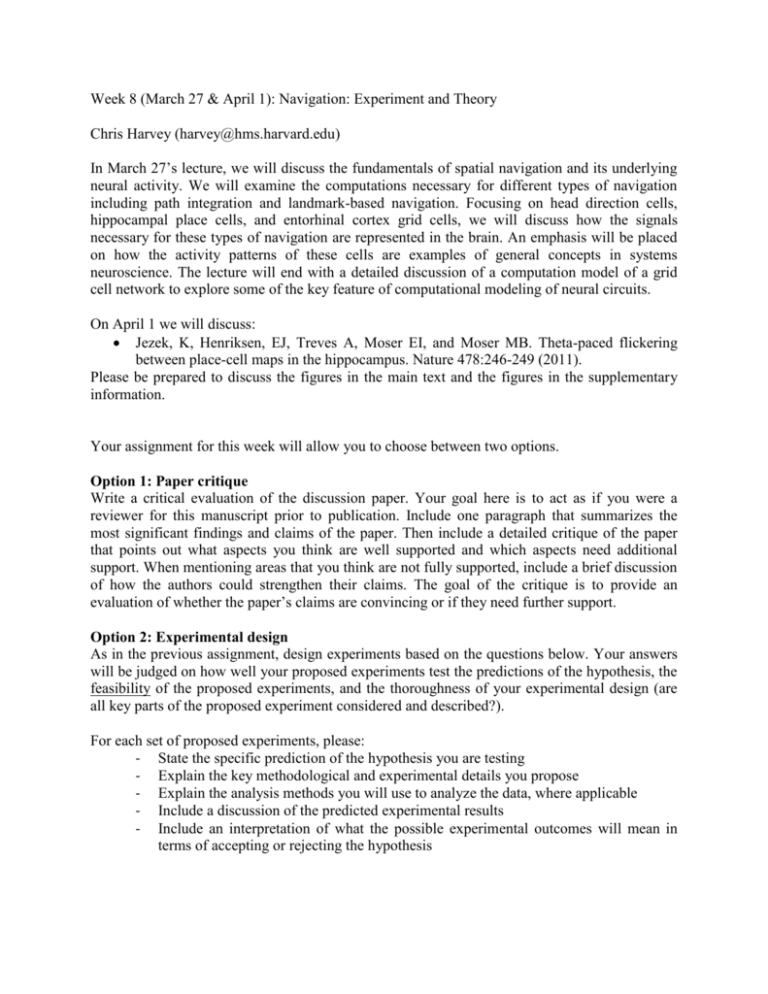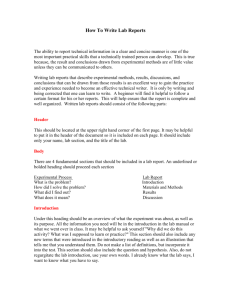Mini-syllabus
advertisement

Week 8 (March 27 & April 1): Navigation: Experiment and Theory Chris Harvey (harvey@hms.harvard.edu) In March 27’s lecture, we will discuss the fundamentals of spatial navigation and its underlying neural activity. We will examine the computations necessary for different types of navigation including path integration and landmark-based navigation. Focusing on head direction cells, hippocampal place cells, and entorhinal cortex grid cells, we will discuss how the signals necessary for these types of navigation are represented in the brain. An emphasis will be placed on how the activity patterns of these cells are examples of general concepts in systems neuroscience. The lecture will end with a detailed discussion of a computation model of a grid cell network to explore some of the key feature of computational modeling of neural circuits. On April 1 we will discuss: Jezek, K, Henriksen, EJ, Treves A, Moser EI, and Moser MB. Theta-paced flickering between place-cell maps in the hippocampus. Nature 478:246-249 (2011). Please be prepared to discuss the figures in the main text and the figures in the supplementary information. Your assignment for this week will allow you to choose between two options. Option 1: Paper critique Write a critical evaluation of the discussion paper. Your goal here is to act as if you were a reviewer for this manuscript prior to publication. Include one paragraph that summarizes the most significant findings and claims of the paper. Then include a detailed critique of the paper that points out what aspects you think are well supported and which aspects need additional support. When mentioning areas that you think are not fully supported, include a brief discussion of how the authors could strengthen their claims. The goal of the critique is to provide an evaluation of whether the paper’s claims are convincing or if they need further support. Option 2: Experimental design As in the previous assignment, design experiments based on the questions below. Your answers will be judged on how well your proposed experiments test the predictions of the hypothesis, the feasibility of the proposed experiments, and the thoroughness of your experimental design (are all key parts of the proposed experiment considered and described?). For each set of proposed experiments, please: - State the specific prediction of the hypothesis you are testing - Explain the key methodological and experimental details you propose - Explain the analysis methods you will use to analyze the data, where applicable - Include a discussion of the predicted experimental results - Include an interpretation of what the possible experimental outcomes will mean in terms of accepting or rejecting the hypothesis Questions: 1. Episodic memory is thought to be a key feature represented in the hippocampus. It is often defined as the simultaneous memory of ‘what’, ‘when’, and ‘where’, e.g. a memory of eating a roast beef sandwich (what) in the HMS café (where) at noon yesterday (when). One debate regarding episodic memory is whether it is specific to humans or is also present in other animals. A graduate student has chosen to test if a lab-raised squirrel has episodic memory. Squirrels bury nuts and then return to the sites of the buried nuts to retrieve food when food is scarce. The squirrel being studied buries two types of nuts, nut A that lasts indefinitely after being buried and nut B that becomes no longer edible after 1 week of being buried. Experiments in the lab have shown that the squirrels can clearly distinguish between nuts A and B and that the squirrels understand that nuts of type B are perishable but that nuts of type A are not. Also, the student has observed that the burying and retrieval behavior is normal for the squirrels in lab settings. You have access to a group of squirrels that will bury and retrieve nuts in a lab setting. Design a behavioral experiment to test if the squirrels have episodic memory for ‘what’, ‘when’, and ‘where’. What behavioral conditions must be satisfied to demonstrate the existence of episodic memory? 2. In Jezek et al, the authors have concluded that there are discrete memories for environments and that neural activity in the hippocampal CA3 population flickers between discrete representations. This was shown using environments that were highly different visually. However, it is possible to imagine cases in which the sensory cues are conflicting or not extremely salient, such that it is difficult for the rat to know in which environment he is in. One hypothesis predicts that given knowledge of two environments and conflicting or subtle sensory cues, flickering between two discrete representations in CA3 would occur, as observed in this paper (i.e. a discrete attractor). A second hypothesis is that when sensory information about the environment is incomplete or confusing, intermediate representations in CA3 could arise (i.e. a continuous attractor). Design an experiment that could help to distinguish between these possibilities. Describe the design of the environments presented to the rat and the types of data that would support each of the hypotheses. Include details of the experimental methods and data analysis approaches.











